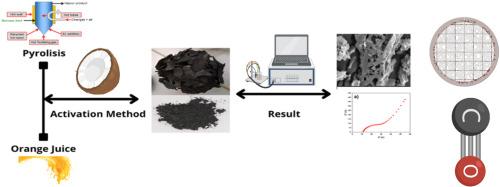从椰子生物质废料中提取多孔硬碳作为超级电容器电极材料
Q3 Materials Science
引用次数: 0
摘要
以椰子生物质废弃物为原料,在500℃、600℃和700℃的不同温度下,分别采用物理活化热解法和以橙汁为有机活化剂的化学活化法合成多孔硬碳。本研究的目的是开发基于这些温度变化的法拉第型超级电容器电极材料。表征和测试方法包括x射线衍射(XRD)、扫描电子显微镜(SEM)、brunauer - emmet - teller (BET)、循环伏安法(CV)和电化学阻抗谱(EIS)。BET分析表明,PHC-700样品具有较高的比表面积和孔隙特征,孔径分布在17-18 nm左右。PHC-700样品具有最佳的电化学性能,比电容为485.23 F/g,总电阻为24.29 Ω。GCD测量显示出稳定的三角形曲线,表明PHC-700具有良好的充放电可逆性,证实了其优越的电容性能。研究证实,使用的温度越高,获得的超级电容器电极越好。表面气孔有助于提高电极质量,XRD测试结果与温度升高成正比,证明了这一点。希望本研究能增进对超级电容器电极应用的认识。本文章由计算机程序翻译,如有差异,请以英文原文为准。

Porous hard carbon derived from coconut biomass waste as electrode material for supercapacitor
The synthesis of porous hard carbon from coconut biomass waste using physical activation through pyrolysis and chemical activation with orange juice as an organic activator at varying temperatures, including 500 °C, 600 °C, and 700 °C, has been carried out. The purpose of this research is to develop materials for faradaic-type supercapacitor electrodes based on these temperature variations. Characterization and testing methods used include X-ray diffraction (XRD), scanning electron microscopy (SEM), Brunauer-Emmett-Teller (BET), cyclic voltammetry (CV), and electrochemical impedance spectroscopy (EIS). BET analysis showed that the PHC-700 sample exhibited a relatively high specific surface area with porous characteristics and a narrow pore size distribution around 17–18 nm. The PHC-700 sample also exhibited the best electrochemical performance with a specific capacitance of 485.23 F/g and a total resistance of 24.29 Ω. GCD measurements revealed stable triangular curves, indicating good charge-discharge reversibility and confirming the superior capacitive behavior of PHC-700. The study confirmed that the higher the temperature used, the better the supercapacitor electrode obtained. This is evidenced by the pores on the surface that help improve the quality of the electrode and the XRD test results which are directly proportional to the increase in temperature. It is hoped that this research can enhance understanding of supercapacitor electrode applications.
求助全文
通过发布文献求助,成功后即可免费获取论文全文。
去求助
来源期刊

JCIS open
Physical and Theoretical Chemistry, Colloid and Surface Chemistry, Surfaces, Coatings and Films
CiteScore
4.10
自引率
0.00%
发文量
0
审稿时长
36 days
 求助内容:
求助内容: 应助结果提醒方式:
应助结果提醒方式:


